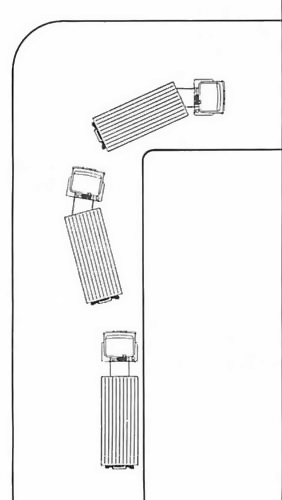Towing
The Video Course teaches you everything about modern cars.
So many drivers tow trailers of one kind or another platforms for boats, horses or racing cars, as well as caravans — that the Institute of Advanced Motorists operates a special towing test. Only existing members who have already passed the advanced test in a car or commercial vehicle are eligible. The basic points to remember when towing a trailer are these:
Braking
You will find that the extra weight, perhaps a ton or more, of a laden trailer will create so much added momentum that stopping distances increase considerably, even if the trailer has overrun brakes. On a long motorway journey with a very stable trailer, never allow yourself to forget temporarily that you are towing, so that you find yourself in the position of having to brake very heavily for a roundabout at the end of an exit slip road.
In traffic
It is vital to allow for the extra width of a trailer, and to remember that the trailer will cut in closer to the kerb than the car itself when negotiating junctions or sharp bends. If it is safe to do so, make a larger arc; alternatively, copy the technique used by drivers of articulated lorries by drawing slightly past the apex of the junction with the 'tractor unit' (your car), then turn the corner sharply.
Rear vision
If you are towing anything other than a flat trailer, the mirrors on your car will be useless. It is essential, therefore, to buy mirrors on extended arms to give yourself adequate rearward vision.
Legal requirements
The law affecting the use of trailers is too complex for all the details to be given here, so check by asking the local police or the company which supplies your trailer. Speed limits vary considerably according to the road and the design of the trailer, and no trailer may be used in lane 3 of a motorway. In addition, there are requirements governing lights, rear reflectors and the display of 50mph warning signs at the rear.
Although it is not a legal requirement, we would recommend that you fit sidelights on a trailer's mudguards; they should show white to the front and red to the rear. This precaution could prevent an accident since other road users frequently fail to see a trailer, particularly if it is unladen.
Manoeuvring

Reversing is what sorts the men from the boys as far as trailers are concerned. It is so tricky when you first attempt it that you would be wise to practise in a wide open space, perhaps in a public car park on a Sunday morning, before you have to do it in tight confines. As soon as you have a go, you will find that the trailer will travel in the opposite direction to that in which the car is heading: if you back round to the left, the trailer will veer to the right.
Overcoming this requires a special technique. If you wish to make the trailer swing to the left, you must begin by reversing to the right; when the trailer has started to line up in the required direction, correct the steering and start backing to the left. Just like any other aspect of driving it takes a little time to master this, but once you have acquired the knack it will seem easy. Always reverse very slowly because any mistake will be quickly compounded as the trailer moves rapidly off course; edge forward and have another go if necessary. In an extreme case it is possible to apply so much steering lock that the trailer jack-knifes and becomes jammed against the towing car's rear bumper. Remember that you may need to latch overrun brakes out of use if they are not to become clamped on as soon as you reverse.
One of the biggest dangers on the open road is the dreaded swing. Many trailers and caravans are prone at certain speeds to begin oscillating from side to side, creating a pendulum effect which produces greater and greater swings until car and trailer are in danger of catapulting themselves off the road — or into another vehicle. Your only course of action is to slow down gently, but make sure that it is gently because heavy braking could launch the unsteady trailer into even more violent swings. Stop as soon as possible in order to adjust the weight on the trailer so that more weight bears down on the drawbar.
Summary
The Ultimate Car Mechanics video course
Learn everything about modern cars from our new video series.
Learn more >-
We build a Mazda MX5 Miata from scratch
We start by tearing down and then rebuilding the whole car.
-
Every part explained
There's ridiculous detail on every part. Clearly and easily explained.
-
All modeled in 3D
We've created the most detailed 3D model ever produced so we can show you everything working.






